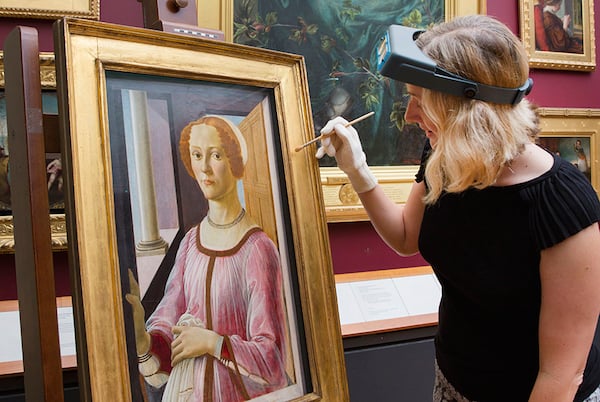
Photo: via Art Daily
New light has been shed on techniques used by Sandro Botticelli by experts at London’s Victoria and Albert Museum while preparing for the major exhibition “Botticelli Reimagined”, which will tour to the London museum from Berlin next year.
The experts made the discovery through uncovering details that lay beneath the paint of Botticelli’s Portrait of a Lady known Smeralda Bandinelli (c. 1470-5).
It had long been believed that founder of the Pre-Raphaelite Brotherhood, the painter Dante Gabriel Rossetti—who purchased the painting from Christie’s London in 1867 for £20—had added to the work by painting in the striking red hair of the sitter.
This was proven by the fact that Rossetti wrote to his secretary, Charles Augustus Howell, on April 1, 1867, admitting, “I have been restoring the headdress, but don’t mean to tell.”
Portrait of a Lady known as Smeralda Bandinelli (c.1470-5), Sandro Botticelli during cleaning testing in the V&A’s paintings conservation studio
Photo: courtesy the V&A
This lead people to believe that the vibrant red hair in the portrait was, for the most part, an addition of Rossetti’s, given its Pre-Raphaelite aesthetic.
But, as conservators removed thick layers of paint and varnish from the painting, it was revealed that the alterations made by Rossetti were more likely to have focused on the face and white cap worn by the sitter.
“In recent decades, technology has deepened our understanding of historic paintings immeasurably,” said Mark Evans, co-curator of the exhibition at the V&A. “Removing the discoloured varnish has reinvigorated Botticelli’s luminous colours and given the Portrait of a Lady known as Smeralda Bandinelli, and her much-debated red hair, a new lease of life.”
The conservators have gained great insight into techniques used by Botticelli
Photo: Courtesy the V&A
Through the use of infrared reflectography—which allows researchers to look through layers of paint revealing details that cannot be seen by the naked eye—the V&A conservators have also gained insight into the way Botticelli designed and painted the portrait, using liquid sketching, and layered paint.
“Botticelli Reimagined”, a collaboration with Gemäldegalerie–Staatliche Museen zu Berlin, is set to become one the blockbuster exhibitions this season. It brings together 150 pieces from around the world and looks at the work of the Renaissance master alongside works by artists and designers inspired by him, including Rossetti, René Magritte, Elsa Schiaparelli, and Andy Warhol.
The Virgin and Child with Two Angels(c.1490), Sandro Botticelli
Photo: Courtesy Gemäldegalerie der Akademie der Bildenden Künste Vienna
“Sandro Botticelli is one of the greatest artists of the Renaissance and 500 years after his death his celebrated imagery has come full circle to represent a contemporary ideal of beauty,” V&A director Martin Roth said of the exhibition, which will open in London in March 2016.
Venus, after Botticelli (2008), Yin Xin
Photo: Courtesy Duhamel Fine Art, Paris
Venus Dress: Look 15, Dolce & Gabbana S/S 1993, Milan, modelled by Karen Mulder
Photo: Courtesy Catwalking.com
Related stories: